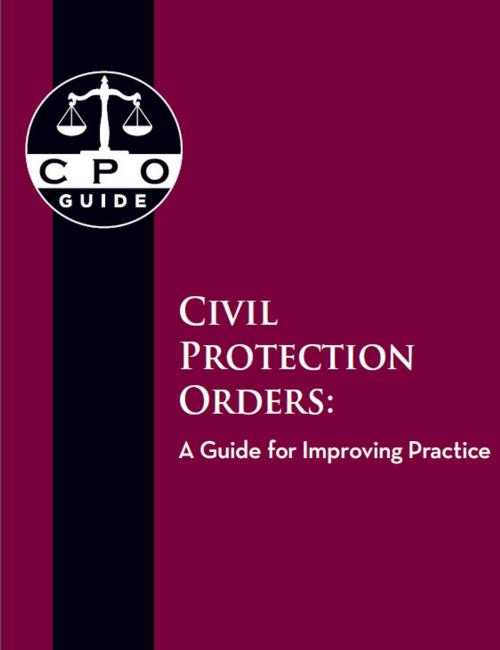Civil Protection Orders: A Guide for Improving Practice
Nonfiction, Reference & Language, Law, Civil Law, Family Law| Author: | National Council of Juvenile and Family Court Judges | ISBN: | 9781476244655 |
| Publisher: | National Council of Juvenile and Family Court Judges | Publication: | March 26, 2012 |
| Imprint: | Smashwords Edition | Language: | English |
| Author: | National Council of Juvenile and Family Court Judges |
| ISBN: | 9781476244655 |
| Publisher: | National Council of Juvenile and Family Court Judges |
| Publication: | March 26, 2012 |
| Imprint: | Smashwords Edition |
| Language: | English |
In 1994, Congress passed the Violence Against Women Act (VAWA), comprehensive legislation designed to address the problem of abuse against women in various forms. Implementation of the measures contained in VAWA has improved the lives of millions of women in the 16 years since its enactment. One small but formidable element is VAWA’s requirement of “full faith and credit for protection orders,” namely that a protection order issued in one jurisdiction must be accorded full faith and credit in others and enforced as though issued in the enforcing jurisdiction. What seemed to be a straightforward concept turned out to be more complex and compelled a multi-faceted, comprehensive approach to implementation. Many initiatives were undertaken.
In 2005, the Family Violence Department (FVD) of the National Council of Juvenile and Family Court Judges (NCJFCJ) published A Guide for Effective Issuance & Enforcement of Protection Orders, which came to be known as the Burgundy Book. This project was a partnership with the Office on Violence Against Women (OVW), U.S. Department of Justice and the National Center on Protection Orders and Full Faith and Credit (formerly the National Center on Full Faith and Credit). The Burgundy Book sought to advance implementation of the VAWA Full Faith and Credit provision by addressing the greatest impediments: inconsistent and often ineffective issuance, service, and enforcement of protection orders. The Burgundy Book was developed as a comprehensive guide to address those issues.
Thousands of copies of the Burgundy Book have been distributed to judges, advocates, law enforcement officers, prosecutors, and attorneys, in this country and abroad, and hundreds of trainings undertaken to educate professionals about issuance and enforcement of protection orders. However, since the Burgundy Book was originally published, Congress passed the Violence Against Women Act of 2005, which clarified and strengthened the Full Faith and Credit provision. States have similarly responded with more nuanced legislation. Also, the explosion in technology provides opportunities for more efficient practice, while opening up new ways in which perpetrators can survey and stalk their victims.
During 2009, the FVD and OVW reconvened some of the country’s finest experts on full faith and credit to re-examine the Burgundy Book. As with the original committee, the group consisted of 25 professionals drawn from the judiciary, law enforcement, advocates, civil attorneys, and prosecutors. The group worked together to identify and evaluate the kind of guidance needed for professionals and ideas for integrating each discipline’s role into one cohesive vision for the protection order process. The result was this guide, Civil Protection Orders: A Guide for Improving Practice (CPO Guide).
The CPO Guide is built on eight essential values that underpin an effective protection order system: safety, autonomy, accessibility, competence, reliability, collaboration, culture and diversity, and community engagement. It acknowledges that improving outcomes requires professionals and systems as a whole to engage with victims and communities in ways that support and advance these values.
Since its publication in 2010, the CPO Guide has become a central tool in the FVD’s and NCJFCJ’s efforts to support judges, other system professionals, and communities in their efforts to increase the safety and improve the lives of both adult and child victims of domestic violence. It has also been recognized by the nation’s highest leadership as critical in the movement to support victims of domestic violence. During Domestic Violence Awareness Month 2010, President Barack Obama announced the CPO Guide would be a component of his administration’s efforts to do more to help domestic violence victims. And, in July 2011, the NCJFCJ’s Board of Trustees passed a resolution unanimously adopting the CPO Guide as official policy of the NCJFCJ.
In 1994, Congress passed the Violence Against Women Act (VAWA), comprehensive legislation designed to address the problem of abuse against women in various forms. Implementation of the measures contained in VAWA has improved the lives of millions of women in the 16 years since its enactment. One small but formidable element is VAWA’s requirement of “full faith and credit for protection orders,” namely that a protection order issued in one jurisdiction must be accorded full faith and credit in others and enforced as though issued in the enforcing jurisdiction. What seemed to be a straightforward concept turned out to be more complex and compelled a multi-faceted, comprehensive approach to implementation. Many initiatives were undertaken.
In 2005, the Family Violence Department (FVD) of the National Council of Juvenile and Family Court Judges (NCJFCJ) published A Guide for Effective Issuance & Enforcement of Protection Orders, which came to be known as the Burgundy Book. This project was a partnership with the Office on Violence Against Women (OVW), U.S. Department of Justice and the National Center on Protection Orders and Full Faith and Credit (formerly the National Center on Full Faith and Credit). The Burgundy Book sought to advance implementation of the VAWA Full Faith and Credit provision by addressing the greatest impediments: inconsistent and often ineffective issuance, service, and enforcement of protection orders. The Burgundy Book was developed as a comprehensive guide to address those issues.
Thousands of copies of the Burgundy Book have been distributed to judges, advocates, law enforcement officers, prosecutors, and attorneys, in this country and abroad, and hundreds of trainings undertaken to educate professionals about issuance and enforcement of protection orders. However, since the Burgundy Book was originally published, Congress passed the Violence Against Women Act of 2005, which clarified and strengthened the Full Faith and Credit provision. States have similarly responded with more nuanced legislation. Also, the explosion in technology provides opportunities for more efficient practice, while opening up new ways in which perpetrators can survey and stalk their victims.
During 2009, the FVD and OVW reconvened some of the country’s finest experts on full faith and credit to re-examine the Burgundy Book. As with the original committee, the group consisted of 25 professionals drawn from the judiciary, law enforcement, advocates, civil attorneys, and prosecutors. The group worked together to identify and evaluate the kind of guidance needed for professionals and ideas for integrating each discipline’s role into one cohesive vision for the protection order process. The result was this guide, Civil Protection Orders: A Guide for Improving Practice (CPO Guide).
The CPO Guide is built on eight essential values that underpin an effective protection order system: safety, autonomy, accessibility, competence, reliability, collaboration, culture and diversity, and community engagement. It acknowledges that improving outcomes requires professionals and systems as a whole to engage with victims and communities in ways that support and advance these values.
Since its publication in 2010, the CPO Guide has become a central tool in the FVD’s and NCJFCJ’s efforts to support judges, other system professionals, and communities in their efforts to increase the safety and improve the lives of both adult and child victims of domestic violence. It has also been recognized by the nation’s highest leadership as critical in the movement to support victims of domestic violence. During Domestic Violence Awareness Month 2010, President Barack Obama announced the CPO Guide would be a component of his administration’s efforts to do more to help domestic violence victims. And, in July 2011, the NCJFCJ’s Board of Trustees passed a resolution unanimously adopting the CPO Guide as official policy of the NCJFCJ.















